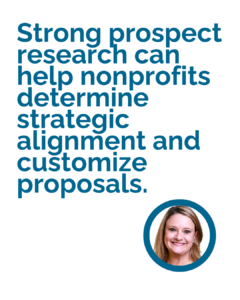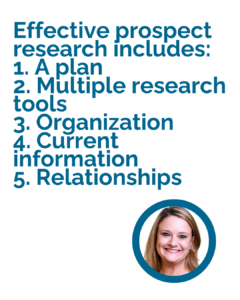At Elevate, we know that identifying and securing grants is often the backbone of nonprofit funding strategies. We also realize that finding the right funders and crafting compelling proposals requires more than just a surface-level search—it demands strategic and comprehensive prospect research. Using multiple research tools is not just recommended; it’s essential for maximizing your grant success. Here’s why and how to do it effectively.
Why Use Multiple Prospect Research Tools?
Grantmakers often don’t reveal their full scope of funding interests on their websites. For example, a glance at the Susan Thompson Buffett Foundation’s website might lead you to believe they only offer scholarships to Nebraska students. However, digging deeper with tools like Candid’s Foundation Directory Online (FDO) or Inside Philanthropy reveals their significant contributions to reproductive health initiatives. This deeper understanding can help nonprofits determine strategic alignment and customize proposals accordingly.
Elevate’s Toolbox for Comprehensive Prospect Research
 At Elevate, leveraging a mix of paid and free prospect research tools ensures high-quality outcomes for clients. Here’s a breakdown of some key tools and how they can elevate your grant-seeking efforts:
At Elevate, leveraging a mix of paid and free prospect research tools ensures high-quality outcomes for clients. Here’s a breakdown of some key tools and how they can elevate your grant-seeking efforts:
1. Salesforce (or your own donor database)
- What It Does: Tracks funder and opportunity records with comprehensive data, including email history and activity logs.
- Why It’s Unique: Elevate’s extensive internal database allows teams to analyze trends across thousands of funders. Collaboration is seamless, as team members can share insights and follow up on opportunities.
2. Candid (FDO)
- What It Does: Provides profiles on nearly 300,000 grantmakers and 2 million grant recipients, along with 990 forms, grant opportunities, and federal grant information.
- Why It’s Unique: Its LinkedIn integration and ability to export data to Excel make it a powerful tool for strategy analysis and networking.
 3. Inside Philanthropy
3. Inside Philanthropy
- What It Does: Features profiles of grantmaking organizations and tracks open RFPs with its GrantFinder tool.
- Why It’s Unique: Users can filter funders by issue, geography, and major donors while accessing articles on philanthropy trends.
4. Instrumentl
- What It Does: Generates comprehensive “funding landscapes” that highlight relevant funders and open opportunities in specific sectors.
- Why It’s Unique: Its “openness to new grantees” insights and high-volume prospect generation set it apart.
5. Free Tools (e.g., LinkedIn, CauseIQ, and Influence Watch)
- What They Do: Provide access to information on influencers, funders, and peer organizations. Tools like LinkedIn help build connections with program officers and grantmakers.
- Why They’re Valuable: Free resources often complement paid tools by filling in gaps or providing quick, high-level insights.
Best Practices for Effective Prospect Research
- Start with a Strategic Plan: Identify your funding priorities and narrow your search to tools and resources that align with your organization’s mission.
- Combine Tools for Deeper Insights: Cross-reference information from multiple sources to uncover hidden opportunities and verify funder alignment.
- Stay Organized: Log your findings, track communication history, and collaborate with your team.
- Stay Current: Regularly review platforms like Inside Philanthropy and the Chronicle of Philanthropy for updates on grantmaking trends.
- Engage with Funders: Use LinkedIn or email to connect with program officers, build relationships, and gain insight into funder priorities.
Conclusion
In today’s competitive funding landscape, successful grant seeking requires more than just a quick Google search. By utilizing multiple prospect research tools, nonprofits can uncover opportunities that align with their mission, craft tailored proposals, and build lasting relationships with funders. With a well-rounded approach to research, your organization can maximize its chances of securing the grants it needs to thrive.
And for more on prospecting, join us for Elevate’s popular Prospect Research: How to Find Grant Opportunities webinar.
About the Author:

Associate Vice President of Continuous Improvement










 At Elevate, leveraging a mix of paid and free prospect research tools ensures high-quality outcomes for clients. Here’s a breakdown of some key tools and how they can elevate your grant-seeking efforts:
At Elevate, leveraging a mix of paid and free prospect research tools ensures high-quality outcomes for clients. Here’s a breakdown of some key tools and how they can elevate your grant-seeking efforts: 3. Inside Philanthropy
3. Inside Philanthropy




